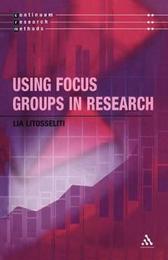
|
Using Focus Groups in Research
Paperback / softback
Main Details
| Title |
Using Focus Groups in Research
|
| Authors and Contributors |
By (author) Dr. Lia Litosseliti
|
| Series | Continuum Research Methods |
|---|
| Physical Properties |
| Format:Paperback / softback | | Pages:104 | | Dimensions(mm): Height 216,Width 138 |
|
| ISBN/Barcode |
9780826464729
|
| Classifications | Dewey:001.433 |
|---|
| Audience | | Tertiary Education (US: College) | | Professional & Vocational | |
|---|
|
Publishing Details |
| Publisher |
Bloomsbury Publishing PLC
|
| Imprint |
Continuum International Publishing Group Ltd.
|
| Publication Date |
1 December 2003 |
| Publication Country |
United Kingdom
|
Description
Focus Groups are often under-used as a valuable tool for research. This practical and extremely well-written guide offers advice on: * planning and organising focus groups * what types of questions to use* the limitations and advantages of using these groups as research methods* collecting the data at group sessions* how to analyse the data produced
Author Biography
Lia Litosseliti is Senior Lecturer in Linguistics and AssociateDean for Internationalisation at City, University of London. Her researchinterests are in the areas of gender and language, discourse analysis andresearch methodologies. She is the author of Using Focus Groups in Research (2003) and Gender and Language: Theory and Practice (2006); editor of Research Methods in Linguistics (2010/2018); and co-editor of Gender Identityand Discourse Analysis (2002, with Jane Sunderland), Gender and Language Research Methodologies (2008, with Kate Harrington, Helen Sauntson, and Jane Sunderland) and Gender and Language in African Contexts (2013, with Lilian Atanga,Sibonile Ellece and Jane Sunderland). Lia was President of the InternationalGender and Language Association (IGALA) and Associate Editor of Gender andLanguage, and has acted as reviewer for a range of funding bodies and journals. t-->
Reviews'Intended as an introduction to Focus Groups for research students, this book is a god-send for anyone considering the pros and cons of this approach, and a valuable practical toolkit for putting focus groups together. Its academic background makes this even more useful. It is properly referenced throughout, and sufficiently rigorous for its stated purpose - supporting MPhil and PHD students. Despite this - or perhaps because of it - it is written in clear, accessible English and introduces all the necessary concepts as it goes along.' * Amazon.Com Books *
|